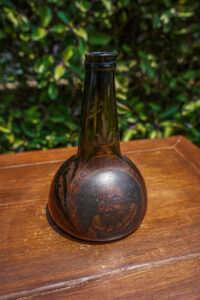
18th Century Dutch Painted Horse Hoof Bottle Depicting Piet Hein
Item #CC-0559 | 18th Century Dutch Horse Hoof Bottle – Depicting Piet Hein
Origin: Holland or Belgium
Date of Manufacture: Circa 1750-1770
Type: Long neck horse hoof
Dimensions: 7″ tall x 4″ wide base
Condition: Very Good
Description: This is a Dutch hand blown bottle known as a long neck horse hoof. The fact that this bottle has survived for over 300 years and traveled from Europe unbroken or cracked is nothing short of a miracle. Bottles like this were often decorated by Dutch painters on a variety of different types and sizes of bottles to commemorate naval victories, honor dignitaries and heroes, display coats of arms, and a wide variety of other artwork.
On the front side of this bottle is displayed a portrait of Admiral Piet Pieterszoon Hein (25 November 1577 – 18 June 1629) who was a Dutch admiral and privateer for the Dutch Republic. On the backside of the bottle is a beautiful coat of arms depicting a lion on a red background.
 In 1628, during the eighty years-long Dutch war of liberation from Spain, Admiral Hein, with Witte de With as his flag captain, sailed out to capture a Spanish treasure fleet loaded with silver from the Spanish American colonies and the Philippines. With him was Admiral Hendrick Lonck. He was later joined by a squadron under Vice-Admiral Joost Banckert, as well as the pirate Moses Cohen Henriques. Part of the Spanish fleet in Venezuela had been warned because a Dutch cabin boy had lost his way on Blanquilla island and was captured and betrayed the plan, but the other half of the fleet from Mexico continued on its voyage, unaware of the threat. Sixteen Spanish ships were intercepted and captured by the Dutch: one galleon was taken after a surprise encounter during the night, nine smaller merchants were talked into surrendering, two fleeing small ships were taken at sea, and four fleeing galleons were trapped on the Cuban coast in the Bay of Matanzas. For more information on the Battle of Matanzas, visit: https://en.wikipedia.org/wiki/Battle_in_the_Bay_of_Matanzas
In 1628, during the eighty years-long Dutch war of liberation from Spain, Admiral Hein, with Witte de With as his flag captain, sailed out to capture a Spanish treasure fleet loaded with silver from the Spanish American colonies and the Philippines. With him was Admiral Hendrick Lonck. He was later joined by a squadron under Vice-Admiral Joost Banckert, as well as the pirate Moses Cohen Henriques. Part of the Spanish fleet in Venezuela had been warned because a Dutch cabin boy had lost his way on Blanquilla island and was captured and betrayed the plan, but the other half of the fleet from Mexico continued on its voyage, unaware of the threat. Sixteen Spanish ships were intercepted and captured by the Dutch: one galleon was taken after a surprise encounter during the night, nine smaller merchants were talked into surrendering, two fleeing small ships were taken at sea, and four fleeing galleons were trapped on the Cuban coast in the Bay of Matanzas. For more information on the Battle of Matanzas, visit: https://en.wikipedia.org/wiki/Battle_in_the_Bay_of_Matanzas
After some musket volleys from Dutch sloops, the crews of the galleons also surrendered and Hein captured 11,509,524 guilders of booty in gold, silver, and other expensive trade goods, such as indigo and cochineal (an insect used to make crimson colored dye), without any bloodshed. The Dutch did not take prisoners: they gave the Spanish crews ample supplies for a march to Havana. The released were surprised to hear the admiral personally giving them directions in fluent Spanish; Hein after all was well acquainted with the region as he had been confined to it during his internment after 1603.
The capture of the treasure fleet was the Dutch West India Company’s greatest victory in the Caribbean. It enabled the Dutch, at war with Spain, to fund their army for eight months and the shareholders enjoyed a cash dividend of 50% for that year. The financial loss strategically weakened their Spanish enemy.
Hein returned to the Netherlands in 1629, where he was hailed as a hero. Watching the crowds cheering him as he stood on the balcony of the town hall of Leyden, he remarked to the burgomaster: “Now they praise me because I gained riches without the least danger; but earlier when I risked my life in full combat they didn’t even know I existed…”. Hein was the first and the last to capture such a large part of a Spanish “silver fleet”. The amount of silver taken was so large that it resulted in the rise of the price of silver worldwide and the near bankruptcy of Spain.
For more information on Hein’s exploits, check out our article here: https://commodorecoins.com/treasure-blog/the-mystery-of-the-lucayan-beach-treasure/. Here is some additional background history on Admiral Hein: https://en.wikipedia.org/wiki/Piet_Pieterszoon_Hein.
Bottles like this are extremely rare and highly sought after by collectors.

